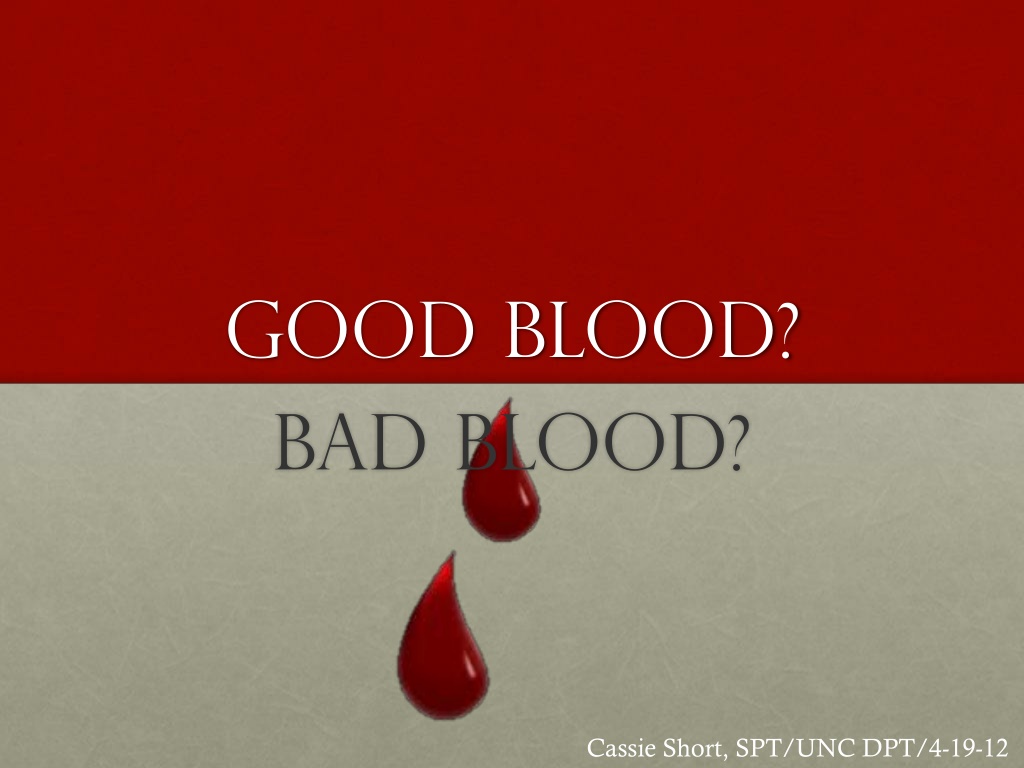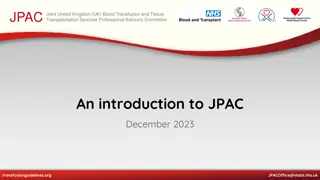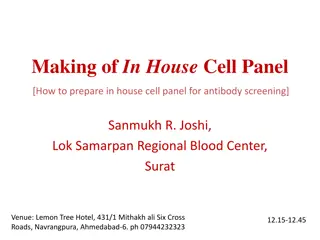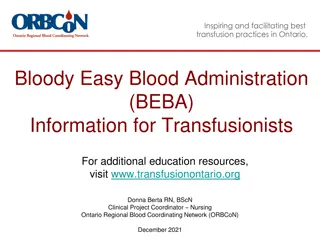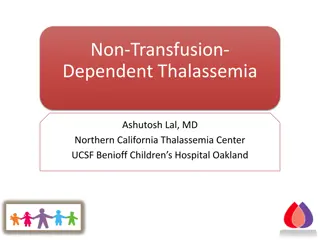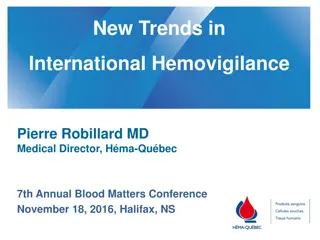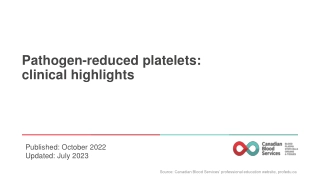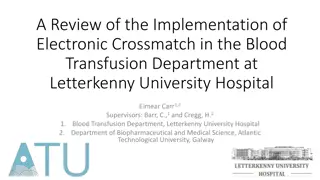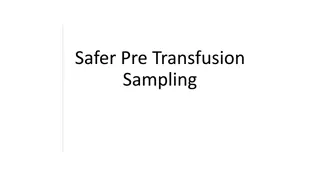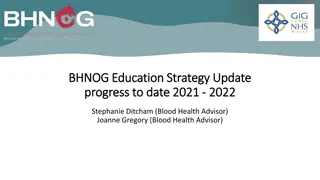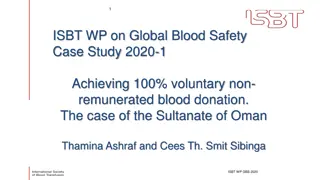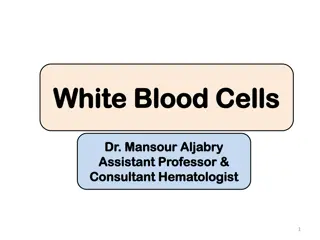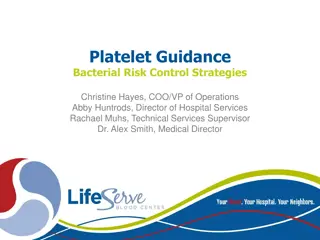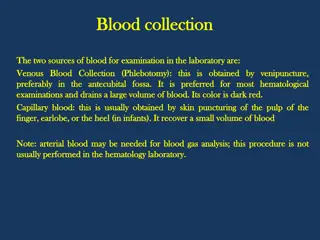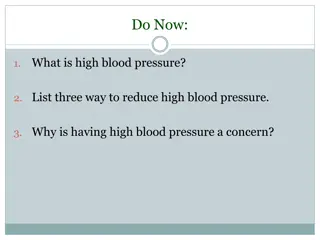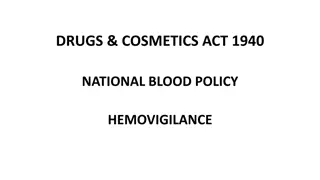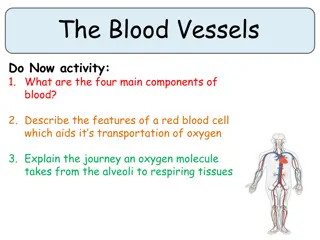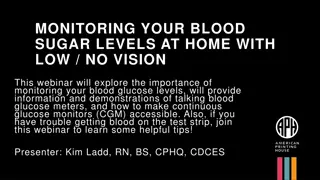Blood Transfusion Process and Implications Studied
Analyzing case studies of patients with different medical histories undergoing blood transfusions, this study examines the implications and adverse events associated with the process. It explores the use of blood transfusions in improving patient outcomes, challenges in managing hemoglobin levels, and common myths surrounding blood transfusions. The study highlights the importance of understanding the risks and benefits of blood transfusions in clinical settings.
Download Presentation

Please find below an Image/Link to download the presentation.
The content on the website is provided AS IS for your information and personal use only. It may not be sold, licensed, or shared on other websites without obtaining consent from the author. Download presentation by click this link. If you encounter any issues during the download, it is possible that the publisher has removed the file from their server.
E N D
Presentation Transcript
Good blood? BAD BLOOD? Cassie Short, SPT/UNC DPT/4-19-12
overview 1. Case Study Examples 2. Blood Transfusions Process Implications Adverse events 3. Physical Therapy Contraindications Indications 4. New Hanover Regional Medical Center Actions
Case Study Examples Mr. A+ Mrs. 0+
Case #1: Mr. A+ Past Medical History: HTN, COPD, Ulcer Disease, ETOH, Hepatitis B, Smoker Admit Date: 04/02/2012 Diagnosis: Melena Hemoglobin at time of admit: 9.7g/L
Yes? NO?
Yes? NO?
Mr. A+ Day 1: 5 Units *last measured Hb: 9.3g/L Day 2: 5 Units *Hb: 8.2g/L Day 3: 2 Units *Hb: 8.5g/L Day 4: 1 Unit *Hb: 9.5g/L ___________________ = 13 UNITS *Total hospital stay = 13 days
Case #2: Mrs. O+ PMHx: SOB, COPD, HTN, DM, CAD, L TKA Admit Date: 03/04/12 Diagnosis: COPD exacerbation Hemoglobin at time of admission: 10.2g/L
Yes? NO?
Yes? NO?
Mrs. o+ Day 1: 2 units *Last measured Hb: 11.1g/L Day 2: 0 units *Hb: 10.5g/L Day 3: 2 units *Hb: 10.9g/L Day 4: 1 unit *Hb: 11.6g/L Day 5: 0 units *Hb: 11.3g/L __________________________ = 5 UNITS *Total hospital stay = 9 days
Fact or Myth? Blood is safer than it s ever been. A blood transfusion will get the patient home sooner. Blood transfusions improve healing. Blood is stored up to 42 days. Autologous blood (pre-donated) is risk-free. Blood transfusion is free. There is a 50% increased risk for infection per 1 unit of RBC s.
Blood transfusions Process Implications Adverse Events
Blood transfusions Process Autologous or Allogenic Separated into components Tested for infections Leukoreduction Pathogen Reduction Treatment Compatibility Testing Donor cross-match testing Delivery for transfusion
ONE UNIT of RBCs 42.5-80 g of Hemoglobin (128-240 mL of pure RBCs) 147-278 mg of Iron (mostly in form of Hemoglobin) Increase hemoglobin level by ~1g/dL, Hematocrit by 3% Stored (refrigeration) 35-42 days; half life ~30 days; Frozen up to 10 years
Blood transfusions Indications: Significant, life compromising, blood loss (trauma, surgery) Severe burn victims Women in childbirth and newborn babies (certain cases) Bleeding disorder or illness that causes anemia Contra-indications: Anemia that can be corrected with a non-transfusion therapy Source of blood volume, or oncotic pressure Improve wound healing Sense of well-being *Avoid over-or under-transfusion *Based on clinical assessment and NOT lab values alone
Blood transfusions How can they go wrong? TRALI (transfusion-associated acute lung injury) TACO (transfusion associated circulatory overload) Acute/Delayed hemolytic reactions Febrile, non-hemolytic reactions Allergic reactions Transmissible viruses (HIV, Hepatitis, or CMV)) Bacterial contaminations Incompatibility reactions Transfusion inefficacy (storage lesion) Volume overload Hypothermia
Blood transfusions Blood Storage Lesion Less volume, flexibility of RBCs; increased adherance Release of free Hb Formation of microparticles Nitric oxide interactions All of the above may be pro- inflammatory or pro- thrombotic- ultimately affecting delivery of 02 to tissues Progresses over time
Blood transfusions Objections to Blood Transfusions Personal, Medical, or Religious Jehovah s Witnesses Believe blood is sacred, the Bible says abstain from blood (Acts 15:28,29) Highlighted possible complications associated with transfusion DO accept non-blood alternatives to blood transfusion Other Options: Iron IV (for anemia) or supplement Changes in diet Volume expanders Growth factors Blood Salvaging or Hemodilution Blood substitutes
Blood transfusions Case Study on Iron Deficiency Anemia* Randomized 459 patients with CHF and iron deficiency to receive either placebo or IV iron 50% or treatment group reported, through Patient Global Assessment tool, NYHA functional class, and 6-minute walk test, being much or moderately improved IV iron patients showed improved functional status regardless of Hb > or < 12g/dL prior to treatment
Physical therapy Indications Contraindications
Physical Therapy Indicated if patient is asymptomatic of: Fatigue SOB Chest pain Headache Dizziness Pale skin Nausea Vomiting Contra-indicated if patient is symptomatic of: Fatigue SOB Chest pain Headache Dizziness Pale Skin Nausea Vomiting
Physical therapy What can we do as therapists? Be aware Check hemoglobin prior to working with patient Monitor signs & symptoms of patients (before, during, or after transfusion) throughout your session Communicate with their nurse Educate others Ask questions!
New hanover regional medical center Taking Action!
NHRMC ~15,000 blood transfusions per year Currently working with Strategic Blood ManagementTM ~20 transfusion safety officers throughout U.S. Educate, interact, provide tools for improvement Largest area noted for improvement with transfusion rate: Orthopedics 2-3 year process
nhrmc Good ol Epic! New order set for MD use for transfusions Option to request Last recorded hemoglobin Drop box choices for reasoning Transfusion Triggers Hemoglobin < 7g/L Active blood loss
nhrmc Transfusion Committee Oversee if policies/procedures in place are being implemented Trends Chart audits for transfusion patients Monthly Continuing Education Nursing staff on floors Webinars Any staff member of NHRMC
nhrmc Adverse Event Prevention/Treatment Nursing education on TACO & TRALI 1 recorded in 2011 Accuracy? Patient Education Consent, risks, benefits Choices
nhrmc QUESTIONS!? Tommy Barham, MT (ASCP) SM Manager- Blood Bank, Microbiology, Immunology 910-343-2776 or tommy.barham@nhrmc.org
QUESTIONS? Thank you!
References http://www.bloodmanagement.com http://www.thebloodytruth.com/ http://www.cms.hhs.gov/HospitalAcqCond/ http://www.jointcommission.org/PerformanceMeasurement/PerformanceMeasurement/Blood+Management+- +Utilization.htm Boucher BA, Hannon TJ. Blood management: a aprimer for clinicians. Pharmacotherapy 2007: 27: 1394-411. Collins TA. Packed red blood cell transfusions in critically ill patients. Critical Care Nurse 2011; 31: 25-34. Dzik WH. Emily Cooley Lecture 2002: transfusion safety in the hospital. Transfusion 2003; 43: 1190-9. Goodnough LT. Risks of blood transfusion. [Review][124 refs]. Critical Care Medicine 2003; 31: S678-S686. Lion N, Crettaz D, Rubin O, Tissot JD. Stored red blood cells: a changing universe waiting for its map(s). J Proteomics. 2010. 73(3): 374-85. Roback J. Vascular effects of the red blood cell storage lesion. Hematology: Transfusion Medicine: adverse Complications of Stored Blood, Amer Soc Hematol, 2011. Stiller, K. Safety issues that should be considered when mobilizing critically ill patients. Crit Care Clin 2007. 23;35-53. Taylor RW, Manganaro L, O Brien J et al. Impact of allogenic packed red blood cell transfusion on nosocomial infection rates in the critically ill patient. Crit Care Med 2002; 30: 2249-54.
